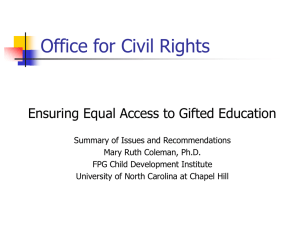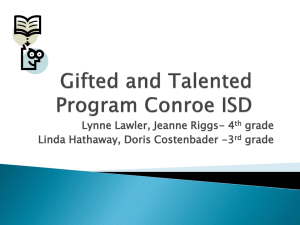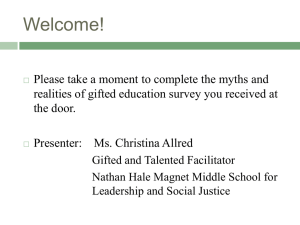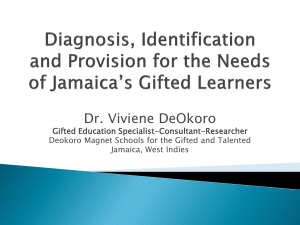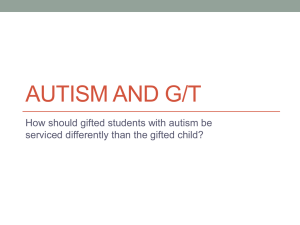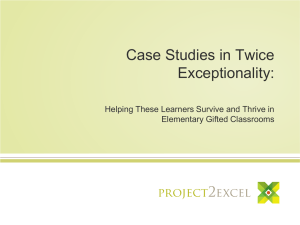The ADHD/ADD Gifted Child
advertisement
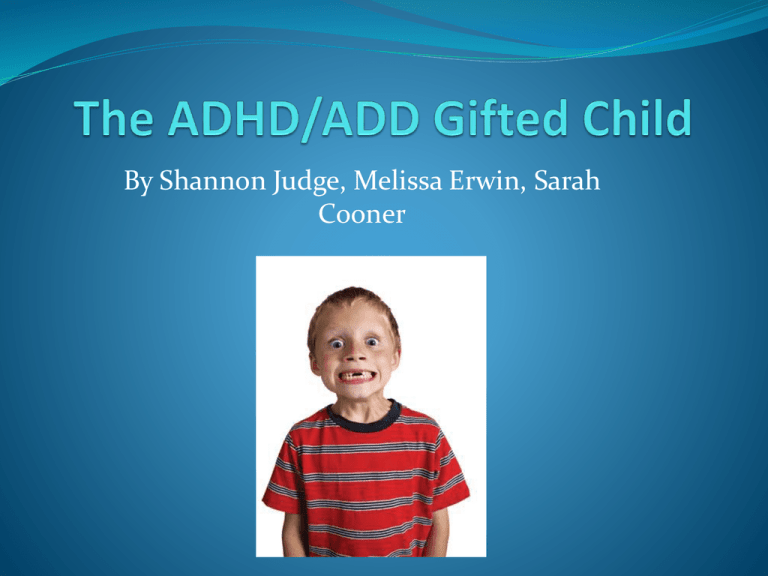
By Shannon Judge, Melissa Erwin, Sarah Cooner ADHD Gifted Characteristics Poorly sustained attention Often shift from one activity to another Impulsivity, poor delay of gratification Impaired adherence to commands to regulate or inhibit behavior in social contexts More active and restless than other children Often talk excessively Often interrupt and intrude on others Hard time following rules and regulations Often looses things, unorganized May appear inattentive to details Highly sensitive to information ADHD Gifted Accommodations Physical Accommodations: Preferential seating (near teacher, between well-focused students, away from distractions) Post schedules on board Standing work station “Time out” spot ADHD Gifted Accommodations Instructional Accommodations: Ask child to repeat back directions when possible Provide extra homework reminders Allow student to use tape recorder or computer Allow specified extended time Create more difficult and intriguing tasks ADHD Gifted Accommodations Behavioral Accommodations: Provide positive verbal or written feedback Provide reward systems and incentives Give tasks that can be completed Develop private signals Be consistent with rewards and consequences Provide student with responsibilities Assign jobs that can be performed well Create tangible goals with timetable Communicate with parents through letters, meetings, and phone calls ADD Gifted Characteristics Behaves similar to other gifted students Inconsistent behaviors- focusing, concentration, stress Research suggests there are differences in their brain structure than the average student Easy success in elementary, but difficulties with the increased work load in junior high and high school ADD Gifted Accommodations preferential seating in the classroom frequent homework reminders less homework small class sizes tutoring and curriculum that allows the student to express his or her creativity ADHD/ADD Gifted Cautions Teachers tend to focus on the disruptive behaviors and fail to see indicators of high ability Later identified may be at risk for developing learned helplessness and chronic underachievement As a group, they tend to lag 2 to 3 years behind their age peers in social and emotional maturity. Keeping the focus on talent development rather than the deficits, appears to yield more positive outcomes and to minimize the problems of social and emotional adjustment Works Cited Http://www.ncpamd.com/Gifted_ADD.htm http://www.davidsongifted.org/db/Articles_id_10132.aspx http://giftedkids.about.com/od/giftedandld/a/gt_and_ld_3 .htm http://www.cec.sped.org/AM/Template.cfm?Section=Hom e&TEMPLATE=/CM/ContentDisplay.cfm&CAT=none&CO NTENTID=1763 http://www.lcps.k12.nm.us/departments/SPED/AES/Broch ures/ADD.pdf http://www.ehow.com/how_5601130_gifted-child-add.html
